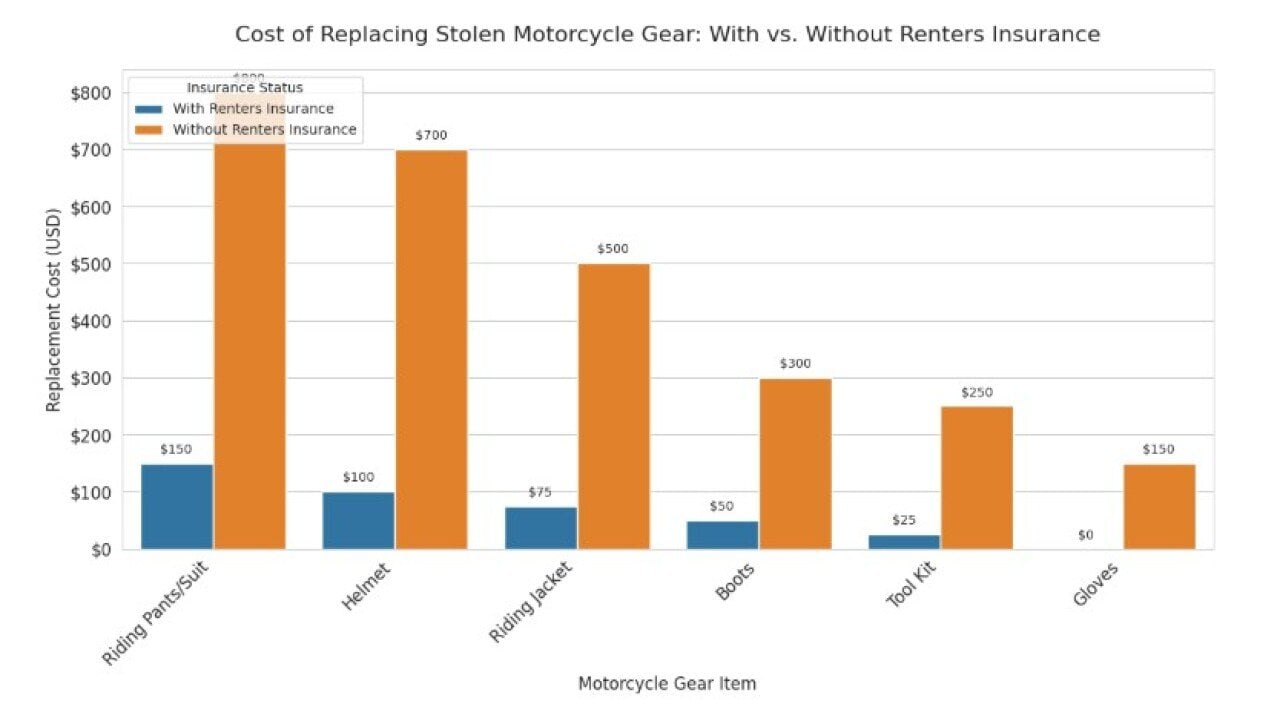When renters insurance steps in to cover stolen motorcycle gear

Michael Vi // Shutterstock
For those who ride, a motorcycle is more than just transportation; it’s an extension of their spirit. Riders invest not just in the bike, but in the gear that keeps them safe and comfortable: the high-impact helmet, the abrasion-resistant jacket, the armored gloves, and the reinforced boots. This gear is essential, and often, it carries a hefty price tag.
But what happens when that essential gear is suddenly gone? Not from a crash, but from a break-in at your apartment, or even from a secured storage unit? The sinking feeling of finding your riding essentials stolen is devastating. You’re not just out hundreds, or even thousands, of dollars; you’re temporarily grounded, sidelined from your passion. This is where your renters insurance policy comes in.
It’s a common misconception that since the loss involves a motorcycle, only motorcycle insurance can help. Thankfully, that’s not entirely true. As CheapInsurance.com explores in this story, while your motorcycle itself is firmly under the wing of your dedicated motorcycle insurance (specifically, the comprehensive portion), the personal property that surrounds your riding life, the gear, is often covered by your humble renters policy.
The Personal Property Lifeline (Coverage C)
The key to understanding this coverage lies in a section of your renters policy known as personal property coverage, often referred to as Coverage C. This part of your policy is designed to protect virtually all of your belongings against “covered perils,” and theft is almost always one of them.
Think of your personal property coverage as a safety net that follows your stuff. When a thief makes off with your premium modular helmet, your custom-fit riding suit, or your essential tool kit, those items fall squarely under the umbrella of personal property. It doesn’t matter that they’re related to a motor vehicle; they are possessions that belong to you, the renter, and they are covered up to the limit you selected when you purchased your policy.
What Does This Mean for Your Riding Gear?
- Helmets: Check. A premium lid can cost upwards of $1,000.
- Jackets, pants, and suits: Check. High-end textiles and leather are significant investments.
- Boots and gloves: Check. All the specialized, armored gear you rely on.
- Bike-specific tools and accessories: Check. If they were stolen from inside your apartment or storage unit, they are personal property.
It’s a huge relief, especially considering that replacing all that gear at once can cripple a rider’s budget.
The Devil is in the Details: Deductibles and Limits
While your policy provides a safety net, it’s not a blank check. To get the most out of your claim, you need to be aware of two critical components: the deductible and the coverage limit.
1. The Deductible
The deductible is your out-of-pocket expense that you must pay before your insurance coverage pays. If you have a $500 deductible and your stolen gear is valued at $2,000, the insurance company will send you a check for $1,500. For lower-value losses (say, just a pair of gloves), you might find that the cost to replace the item is less than or equal to your deductible, making a claim not worthwhile.
2. The Personal Property Limit
This is the maximum amount your insurer will pay out for a covered loss. If you’re a rider who owns multiple sets of high-end gear, has a substantial tool collection, and has thousands of dollars tied up in electronics and home furnishings, a low personal property limit (say, $15,000) could be quickly exhausted. When purchasing or reviewing your policy, it is important to accurately estimate the total replacement cost of all your belongings, including your expensive gear, to ensure your limit is adequate.
Actual Cash Value vs. Replacement Cost Value
Here’s where the cost of your gear’s depreciation comes into play, and it’s a detail every rider should note:
- Actual cash value (ACV): This policy type pays you the depreciated value of your gear. That $800 leather jacket you bought three years ago might only be valued at $300 today.
- Replacement cost value (RCV): This is the gold standard. RCV pays you the cost to buy a brand-new item of similar quality, without deduction for depreciation. While RCV policies cost a bit more in premiums, they are often essential for replacing expensive, rapidly depreciating gear like top-tier helmets and electronics.
When it comes to motorcycle gear, which you rely on for protection, being able to buy new immediately is a huge benefit, making RCV coverage highly recommended for riders.

CheapInsurance.com
Data provided by CheapInsurance.com, representing estimated average replacement costs for new gear and estimated out-of-pocket costs (after deductible) with an assumed renters insurance policy.
The Claim Process: Your Checklist for Recouping Losses
If the unfortunate happens and your gear is stolen, here is your essential action plan.
- File a police report immediately: This is non-negotiable and almost always required by your insurance company. Provide the police with as much detail as possible about the stolen items.
- Document the loss: Take photos of the scene of the theft (e.g., the broken lock on your storage unit, the ransacked closet).
- Gather your inventory: This is why riders should keep a detailed inventory. Find receipts, model numbers, and photographs of the stolen gear. Proof of ownership makes the claims process significantly smoother.
- Contact your renters insurer: Call your provider and file a claim. Be clear that you are claiming the personal property (your gear), and not the motorcycle itself.
When Gear is Stolen Away From Home
Another stellar feature of personal property coverage is that it is often “portable,” which means it covers your belongings even when they are not in your apartment.
- Stolen from your locked car? Covered.
- Stolen from a hotel room while on a road trip? Covered.
- Stolen from a secured storage unit? Covered.
This portability means your renters insurance is a constant companion for your personal belongings, giving you peace of mind whether your gear is hanging in your closet or packed for a cross-country adventure.
The path of the rider is one of freedom, but it shouldn’t be one of financial risk. Your motorcycle gear is a significant investment in your safety and passion. Don’t let a theft ground you permanently. A proactive check of your renters insurance policy can transform it from a forgotten monthly bill into a crucial safety net, one that ensures your stolen gear is replaced and you can quickly get back to the freedom of the open road. Take the time today to review your coverage, understand your limits, and document your gear. It’s the smart rider’s way of preparing for the unexpected detour.
This story was produced by CheapInsurance.com and reviewed and distributed by Stacker.
![]()
